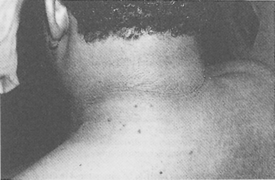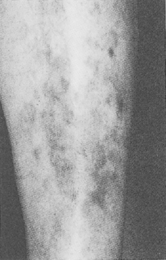Cutaneous manifestations of diabetes mellitus and thyroid disease
1. How often do patients with diabetes mellitus demonstrate an associated skin disorder?
Most published studies report that 30% to 50% of patients with diabetes mellitus ultimately develop a skin disorder attributable to their primary disease. However, if one includes subtle findings such as nail changes, vascular changes, and alteration of the cutaneous connective tissue, the incidence approaches 100%. Skin disorders most often manifest in patients with known diabetes mellitus, but cutaneous manifestations also may be an early sign of undiagnosed diabetes.
2. Are any skin disorders pathognomonic of diabetes mellitus?
Yes. Bullous diabeticorum (bullous eruption of diabetes, diabetic bullae) is specific for diabetes mellitus, but it is uncommon. Bullous diabeticorum most often occurs in patients with severe diabetes, particularly those with associated peripheral neuropathy. In general, all other reported skin findings may be found to some extent in normal individuals. However, some cutaneous conditions (e.g., necrobiosis lipoidica diabeticorum) demonstrate strong associations with diabetes.
3. What is bullous diabeticorum?
Bullous diabeticorum is a blistering disorder that primarily occurs on the distal extremities of diabetic patients. Lesions typically appear as spontaneous tense blisters that are asymptomatic, except for a burning sensation. The exact mechanism is not understood, but most patients have peripheral neuropathy, retinopathy, or nephropathy.
4. What are the skin disorders most likely to be encountered in diabetic patients?
The most common skin disorders are finger pebbles, nail bed telangiectasia, red face (rubeosis), skin tags (acrochordons), diabetic dermopathy, yellow skin, yellow nails, and pedal petechial purpura (Table 55-1). Less common cutaneous disorders that are closely associated with diabetes mellitus include necrobiosis lipoidica diabeticorum, bullous eruption of diabetes, acanthosis nigricans, and scleredema adultorum.
TABLE 55-1.
COMMON CUTANEOUS FINDINGS IN DIABETES MELLITUS
| CUTANEOUS FINDING | INCIDENCE IN CONTROLS (%) | INCIDENCE IN DIABETIC PATIENTS (%) |
| Finger pebbles | 21 | 75 |
| Nail bed telangiectasia | 12 | 65 |
| Rubeosis (red face) | 18 | 59 |
| Skin tags | 3 | 55 |
| Diabetic dermopathy | Uncommon | 54 |
| Yellow skin | 24 | 51 |
| Yellow nails | Uncommon | 50 |
| Erythrasma | Uncommon | 47 |
| Diabetic thick skin | Uncommon | 30 |
Finger pebbles (Huntley’s papules) are multiple, grouped minute papules that tend to affect the extensor surfaces of the fingers, particularly near the knuckles. They are asymptomatic and may be extremely subtle in appearance. Histologically, finger pebbles are the result of increased collagen in the dermal papillae. The pathogenesis is not understood.
6. What is acanthosis nigricans?
Acanthosis nigricans is a skin condition caused by papillomatous (wartlike) hyperplasia of the skin. It is associated with various conditions, including diabetes mellitus, obesity, acromegaly, Cushing’s syndrome, certain medications, and underlying malignant diseases. Acanthosis nigricans associated with insulin-dependent diabetes has been linked to insulin resistance by three mechanisms: type A (receptor defect), type B (antireceptor antibodies), and type C (postreceptor defect). It is proposed that, in insulin-resistant states, hyperinsulinemia competes for the insulin-like growth factor receptors on keratinocytes and thus stimulates epidermal growth. In the case of hypercortisolism, as seen in Cushing’s disease, there is induced insulin resistance, which is believed to induce epidermal growth.
7. What does acanthosis nigricans look like?
It is most noticeable in axillary, inframammary, and neck creases, where it appears as hyperpigmented velvety skin that has the appearance of being “dirty” (Fig. 55-1). The tops of the knuckles may also have small papules that resemble finger pebbles, except that they are more pronounced (Fig. 55-2).
8. What is diabetic dermopathy?
Diabetic dermopathy (shin spots or pretibial pigmented patches) is a common affliction of diabetic patients that initially manifests as erythematous to brown to brownish-red macules that typically measure 0.5 to 1.5 cm, with variable scale on the pretibial surface (Fig. 55-3). The lesions are typically asymptomatic but are occasionally pruritic or are associated with a burning sensation. Patients with diabetic dermopathy are more likely to have retinopathy, nephropathy, and neuropathy. The lesions heal with varying degrees of atrophy and hyperpigmentation over 1 to 2 years. The pathogenesis is unknown, but skin biopsies from the lesions demonstrate diabetic microangiopathy characterized by a proliferation of endothelial cells and thickening of the basement membranes of arterioles, capillaries, and venules associated with deposition of hemosiderin. Although many physicians attribute these lesions to trauma, this view is not supported by an unusual study in which patients with diabetes mellitus failed to develop lesions after they were struck on the pretibial surface with a hard rubber hammer. Diabetic dermopathy has no known effective treatment.
9. What is necrobiosis lipoidica diabeticorum?




